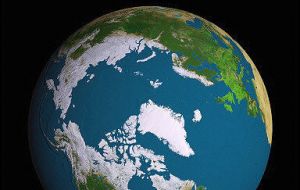MercoPress. South Atlantic News Agency
Success of Polar Year confirms worst climate change fears

Scientists and policymakers marked the official end of the International Polar Year (IPY) Wednesday at the World Meteorological Organization in Geneva. The 60-country, 1.2 billion US dollars effort has seen knowledge about the poles - and their influence on the rest of the planet - increase hugely.
That knowledge is not just about ice and polar bears, but also about Arctic peoples and global climate systems. The WMO has released its preliminary report "The State of Polar Research". The summary of results outlines what has been learned so far from IPY projects: sea level rises due to the melting of ice sheets, sea-ice decreases in the Arctic, anomalous warming in the Southern Ocean, and the storage and release of methane in permafrost. The IPY effort is the largest international science collaboration since the International Geophysical Year, which took place 50 years ago - and comes at a critical time. "The International Polar Year 2007/2008 came at a crossroads for the planet's future" said Michel Jarraud, secretary-general of the WMO. "The new evidence resulting from polar research will strengthen the scientific basis on which we build future actions." And although the IPY officially comes to a close Tuesday, the wheels have been set in motion for a great many projects that will continue on. Broadly speaking, European countries signed up to and began their IPY projects straight out of the starting gate, with North American projects starting later and still ongoing. "Everyone's excited about what they've been able to do," says IPY international program office director David Carlson. "But they're still very much in the 'discovery phase'; it's way too early to say we've concluded this or that." The scope of the projects of this fourth, most recent IPY cannot be overstated. Besides the detailed study of the geophysical and climatic systems of the poles, IPY projects studied biodiversity, epidemiology, and even sociological issues in the Arctic. "The previous IPY story had it that the typical Arctic family was five: two parents, two children and an anthropologist," Dr Carlson told BBC News. "We wanted to get out of that pattern and set a goal of engaging the northern residents through their communities and through their own education and research institutions as full partners. "We don't think you can understand the current or future Arctic without understanding the health and well-being of the people up there." As a result, Arctic peoples were and are actively involved in the research, ranging from climate monitoring to measuring local wildlife populations. Another facet of the effort was to maximise public engagement across a number of disciplines. Catherine Brechignac, President of the International Council for Science, said that "the planning for IPY set ambitious goals that have been achieved, and even exceeded, thanks to the tireless efforts, enthusiasm, and imagination of thousands of scientists, working with teachers, artists, and many other collaborators". The interaction with the education sector has been particularly successful, according to Dr Carlson. "What we've shown is that the education systems - enthusiastic teachers around the world - are hungry for fresh climate information and for a sense that science is doing the right thing at the right time," he said. "Whether we deserve it or not, I think IPY is a positive answer to those messages." Of course, one of the principal aspects of IPY has been to study the intricacies of the poles' geophysical and climatic systems. A theme that seems to be developing from the results so far, Dr Carlson said, is one of unexpected speed. "We have enough to say the whole ice/ocean/atmosphere system in both hemispheres is changing faster than we thought. "The French vessel Tara was going to drift across the Arctic, following the track of the Fram, the Norwegian vessel that did it 100 years before. "All of our models - how fast the ice drifts, how fast the currents flow, and in fact all our logistics - were based on the fact that it was going to take 30 to 36 months and it went across in 14," Dr Carlson said. "That was a signal to us that not just ice but the whole Arctic system is in a fundamentally different state than 12 months before." That means that another 50 years is too long to wait for another effort on this scale. "It would be scientifically a failure and we would be remiss if we didn't call attention to this and get back in there and look at it again quickly," Dr Carlson added. "It's like a diagnosis from your physician that we had better watch some issue and couldn't wait the normal time between check-ups to look at it again". (BBC)




Top Comments
Disclaimer & comment rulesCommenting for this story is now closed.
If you have a Facebook account, become a fan and comment on our Facebook Page!